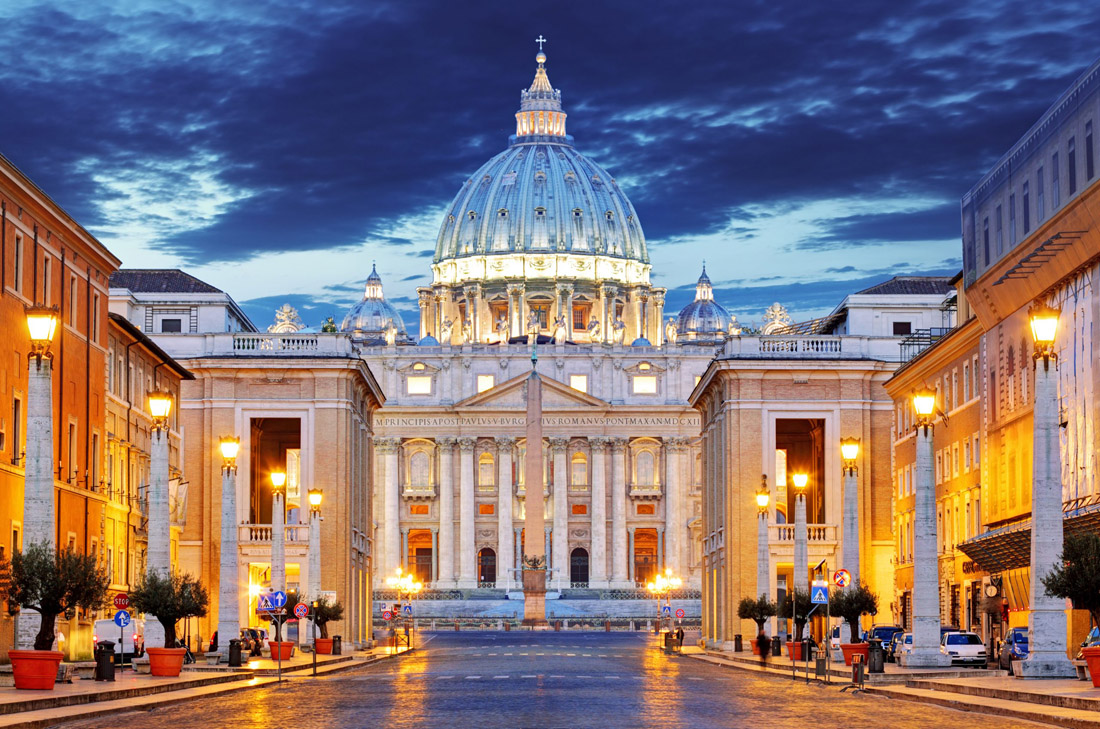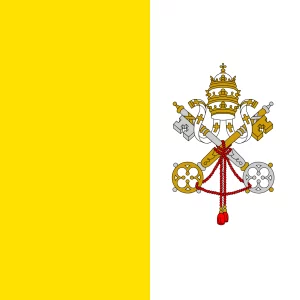Vatican

St. Peter's Basilica
The centerpiece of the Vatican and one of the best places to visit, the magnificent St. Peter’s Basilica was built between the 16th and 18th centuries, replacing earlier structures that began in 326 on what is thought to be where St. Peter was buried. Ironically, it was the selling of indulgences to finance this building in the 16th century that provoked Martin Luther to begin the Protestant Reformation.
The work of famous artists begins before you enter the church: in the portico are an equestrian statue of Constantine by Bernini and fragments of a mosaic by Giotto above the main doorway. It’s from the old church, as are the double bronze doors.
Sistine Chapel
Built by Pope Sixtus IV in 1473-84, the Sistine Chapel is a rectangular hall, which is the Pope’s domestic chapel, also used for services and special occasions. After the death of a Pope, the conclave to elect his successor is held here. The frescoes by Michelangelo and others covering the walls and ceiling, acknowledged as the pinnacle of Renaissance painting, were extensively restored from 1980 to 1994, removing layers of candle-soot, dust, varnish, grease, and overpainting to reveal their original luminous colors. The side walls are covered with large frescoes of Biblical scenes against the background of Umbrian and Tuscan scenery, painted for Sixtus IV by the most celebrated painters of the day – Perugino, Botticelli, Rosselli, Pinturicchio, Signorelli, and Ghirlandaio. These late-15th-century paintings already reflect the ideas of humanism, recognizing humans as individuals and important in the historical process. The left-hand wall shows Old Testament scenes; the right wall New Testament scenes.
Museo Pio Clementino
The Vatican Museums have the largest collection of ancient sculpture in the world, mainly found in Rome and the surrounding areas, most of it displayed in the systematic arrangement designed by Popes Clement XIV and Pius VI from 1769 to 1799. These galleries contain such a wealth of magnificent and significant pieces that even a list of the highlights is a long one. In the Sala a Croce Greca, don’t miss the red porphyry sarcophagi of Constantine’s daughter, Constantia, and his mother, St. Helen, both richly decorated with figures and symbols. In the Sala delle Muse look for Belvedere Torso, a first-century-BC work by Apollonius of Athens that was admired by Michelangelo. In the Gabinetto delle Maschere is a mosaic floor of theatrical masks from the Villa Adriana in Tivoli. In the Cortile del Belvedere is one of the most famous statues in the Vatican: the Apollo Belvedere. In the Galleria delle Statue notice the Candelabri Barberini,the finest ancient candelabras known, also from the Villa Adriana at Tivoli. Galleria dei Busti contains, along with lunette frescoes by Pinturicchio, the celebrated Laocoön group, a masterpiece of Hellenistic sculpture showing the Trojan priest Laocoön and his sons in a mortal struggle with two huge snakes.
Pinacoteca (Picture Gallery)
Even though it was robbed of many of its treasures by Napoleon, the Pinacoteca contains 16 rooms of priceless art from the Middle Ages to contemporary works. Arranged in chronological order, the pictures give an excellent survey of the development of Western painting. Medieval art includes Byzantine, Sienese, Umbrian, and Tuscan paintings, as well as a Giotto triptych and a Madonna and St. Nicholas of Bari by Fra Angelico. There is a triptych by Filippo Lippi, Coronation of the Virgin by Pinturicchio, and a Madonna by Perugino. A room is devoted to tapestries from cartoons by Raphael; his Madonna of Foligno; and his last painting, the famous 1517 Transfiguration. Portraits include da Vinci’s unfinished St. Jerome, a Titian Madonna, and Caravaggio’s Entombment.
Piazza San Pietro (St. Peter's Square)
The grand Piazza San Pietro in front of St. Peter’s Basilica was laid out by Bernini between 1656 and 1667 to provide a setting where the faithful from all over the world could gather. It still serves that purpose admirably, and is filled to capacity each Easter Sunday and on other important occasions. The large oval area, 372 meters long, is enclosed at each end by semicircular colonnades surmounted by a balustrade with 140 statues of saints. On either side of the oval are fountains, and in the center is a 25.5-meter Egyptian obelisk brought from Heliopolis by Caligula in AD 39 and set up in his circus. It was moved here in 1586, no small task in those days as the monument weighs 350 tons. The focal point, however, is the façade of the basilica, from whose central balcony the Pope delivers his blessings and announces beatifications and canonizations. From here also, the senior member of the College of Cardinals proclaims the name of a new Pope elected by the conclave.
Vatican Necropolis
Beneath the grand dome and priceless frescoes of St. Peter’s, a treasure trove of archaeological finds awaits. Many are aware of the papal grottoes just beneath the cathedral where former Popes have been entombed in private chapels, and the 12th-century church that accompanies them. What some don’t know is that there are extensive ruins, which have been excavated even deeper in the earth below, revealing burial grounds from as early as the 1st century BCE. The deepest of the three levels contains a pagan burial site, and the next level up contains both pagan and Christian graves, as well as ruins including stone crypts and arches dating through the 5th century. The most significant discovery, however, is a gravesite believed to contain the remains of Saint Peter himself, a relic that the Vatican continues to excavate with painstaking care. A limited number of tourists are allowed to visit each day, and tickets must normally be purchased directly from the Vatican Excavations Office, so it is highly recommended that tourists book a pre-arranged private tour of the Vatican necropolis, which will ensure admission.




